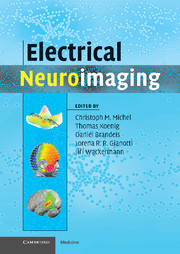Book contents
- Frontmatter
- Contents
- List of contributors
- Preface
- 1 From neuronal activity to scalp potential fields
- 2 Scalp field maps and their characterization
- 3 Imaging the electric neuronal generators of EEG/MEG
- 4 Data acquisition and pre-processing standards for electrical neuroimaging
- 5 Overview of analytical approaches
- 6 Electrical neuroimaging in the time domain
- 7 Multichannel frequency and time-frequency analysis
- 8 Statistical analysis of multichannel scalp field data
- 9 State space representation and global descriptors of brain electrical activity
- 10 Integration of electrical neuroimaging with other functional imaging methods
- Index
- References
4 - Data acquisition and pre-processing standards for electrical neuroimaging
Published online by Cambridge University Press: 15 December 2009
- Frontmatter
- Contents
- List of contributors
- Preface
- 1 From neuronal activity to scalp potential fields
- 2 Scalp field maps and their characterization
- 3 Imaging the electric neuronal generators of EEG/MEG
- 4 Data acquisition and pre-processing standards for electrical neuroimaging
- 5 Overview of analytical approaches
- 6 Electrical neuroimaging in the time domain
- 7 Multichannel frequency and time-frequency analysis
- 8 Statistical analysis of multichannel scalp field data
- 9 State space representation and global descriptors of brain electrical activity
- 10 Integration of electrical neuroimaging with other functional imaging methods
- Index
- References
Summary
Introduction
The raw data for electrical neuroimaging is the potential field recorded on the scalp using multichannel EEG systems. Unlike waveform analysis of EEG or evoked potential (EP), electrical neuroimaging is based on the spatial analysis of these potential maps. The quality of these maps determines the goodness of the subsequent analysis steps. It is therefore of crucial importance that these scalp potential fields are recorded and pre-processed in a correct manner. An important issue concerns the number and the distribution of the electrodes on the scalp to provide an adequate spatial sampling of the potential field. Another issue is the measurement of the exact position of each electrode and the spatial normalization of the potential fields when averaging over subjects. Artifact detection and elimination is also an important point, since noise crucially influences source analysis. On the other hand, some factors that pose important problems for the traditional waveform analysis are irrelevant for electric neuroimaging. Obviously the selection of the “correct montage” for EEG analysis, or the “correct electrode” for evoked potential analysis is not relevant when analyzing the potential field. However, most important is that the question of the correct reference is completely obsolete for electrical neuroimaging. This fact was unfortunately often ignored and the “reference-problem” has been considered as a major disadvantage of the EEG compared with the MEG.
- Type
- Chapter
- Information
- Electrical Neuroimaging , pp. 79 - 92Publisher: Cambridge University PressPrint publication year: 2009
References
- 7
- Cited by



